Removal Procedure
Caution: Avoid taking the following actions when you service wheel brake parts:
| • | Do not grind brake linings. |
| • | Do not sand brake linings. |
| • | Do not clean wheel brake parts with a dry brush or with compressed air. |
- Use a siphon in order to remove half of the brake fluid from the master cylinder
reservoir.
- Raise and support the vehicle. Refer to
Lifting and Jacking the Vehicle
in General Information.
- Remove the tire and wheel assembly from the vehicle. Refer to
Tire and Wheel Removal and Installation
in Tires and
Wheels.

- Install a large C-clamp over the brake caliper. Position the ends of the C-clamp
against the rear of the caliper body and against the outer brake pad.
- Tighten the C-clamp in order to compress the caliper piston into the
caliper bore.
- Remove the C-clamp from the caliper.
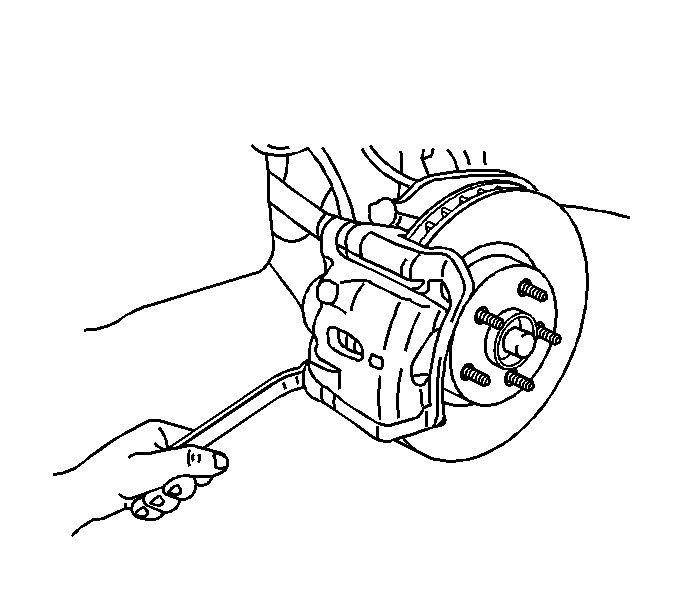
- Remove the 2 caliper bolts.
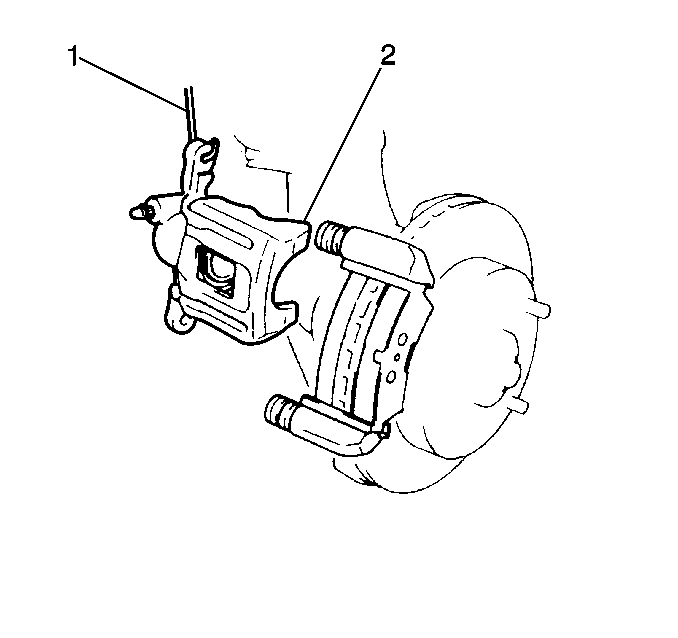
Notice: Support the brake caliper with heavy mechanic wire, or equivalent,
whenever it is separated from its mount and the hydraulic flexible brake hose is still connected. Failure to support the caliper in this manner will cause the flexible brake hose to bear the weight of the caliper, which may cause damage to the brake hose and
in turn may cause a brake fluid leak.
- Remove the caliper housing (2) from the caliper bracket. Support the
caliper with a wire (1) in order to prevent damage to the brake hose.
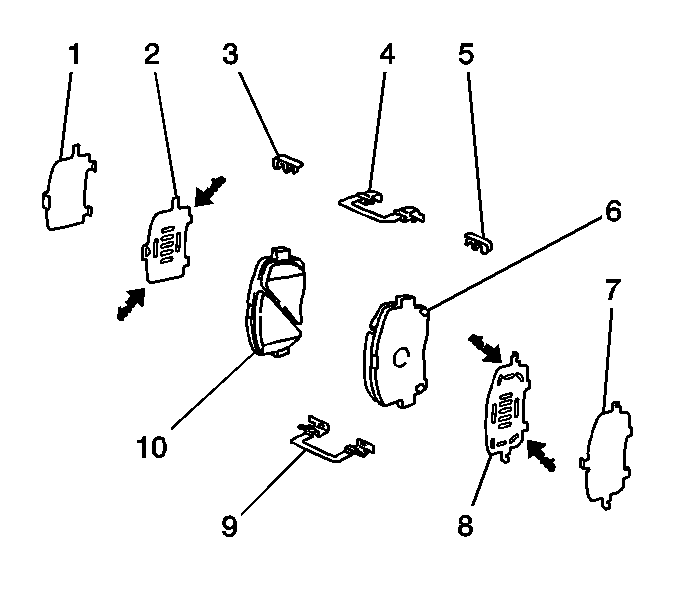
- Remove the 2 brake pads (6,10).
- Remove the inner pad wear indicator (3) from the inner pad.
- Remove the outer pad wear indicator (5), if equipped, from the
outer pad.
- Remove the 2 insulators (1,7).
- Remove the 2 pad insulators (2,8).
Important: Note the location of the upper retainer and
the lower retainer. The upper retainer is not interchangeable with the lower retainer.
- Remove the 2 brake pad retainers (4,9).
Inspection Procedure
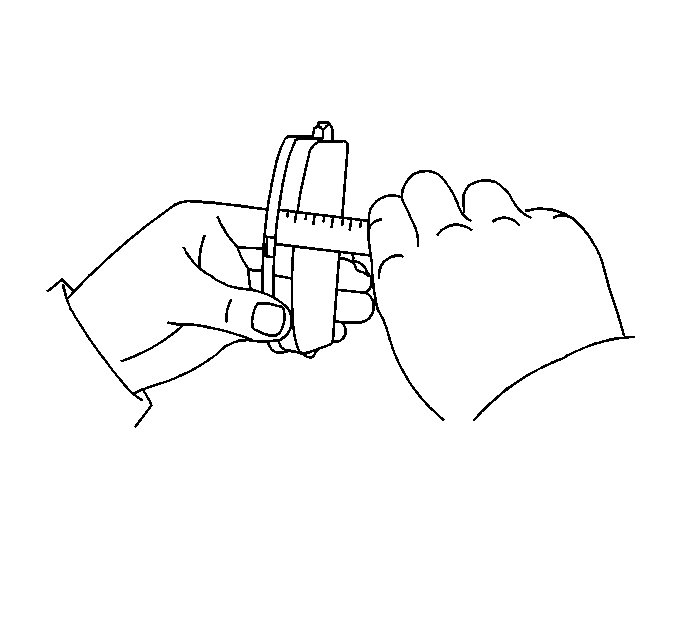
- Inspect the brake pads for wear. If the pad thickness is less than specification,
replace the disc brake pads in axle sets.
Specification
The minimum brake pad lining thickness is
1 mm (0.039 in).

- Clean the 2 brake pad retainers (4,9).
Inspect the retainers for the following conditions:
| • | If the retainers meet the above conditions, re-use
the retainers. |
- Clean and inspect the disc brake hardware. Replace components if necessary.
Refer to
Front Disc Brake Mounting and Hardware Inspection
.
- Clean and inspect the caliper. Repair or replace components as necessary.
Refer to
Brake Caliper Inspection
.
Important: Refinish or replace the rotor ONLY if the
condition of the rotor requires service. DO NOT refinish the rotor if the brake pads
are the only components requiring service.
- Measure the brake rotor thickness. Refinish or replace the rotor as necessary.
Refer to
Brake Rotor Thickness Measurement
.
- Measure the brake rotor thickness variation. Refinish or replace the rotor
as necessary. Refer to
Brake Rotor Thickness Variation Measurement
.
- Inspect the surface of the brake rotor. Refinish or replace the rotor
as necessary. Refer to
Brake Rotor Surface and Wear Inspection
.
- Measure the brake rotor assembled lateral runout. Refinish or replace
the rotor as necessary. Refer to
Brake Rotor Assembled Lateral Runout Measurement
.
Installation Procedure
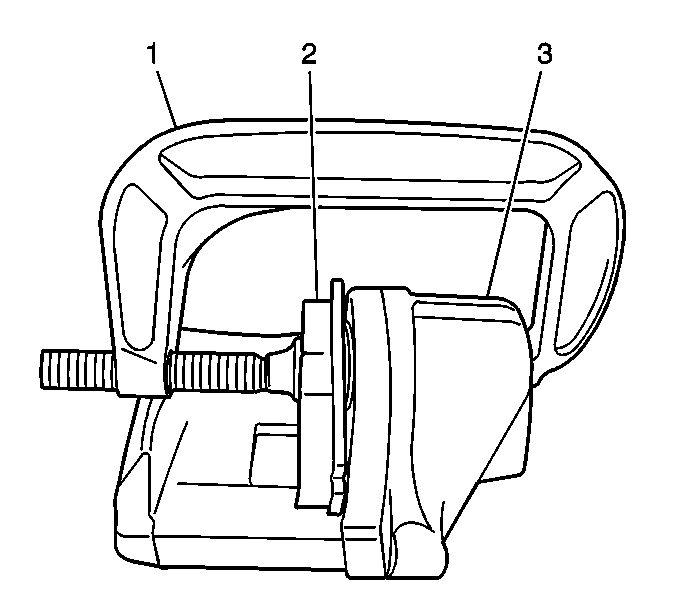
- If the caliper piston is not compressed
into the caliper bore, complete the following steps:
| 1.1. | Place an old brake pad (2) or a block of wood against the caliper
piston. |
| 1.2. | Install a large C-clamp over the body of the brake caliper. |
| 1.3. | Position the ends of the C-clamp against the rear of the caliper body
and against the pad or the wood. |
| 1.4. | Tighten the C-clamp in order to compress the caliper piston into the caliper
bore. |

- Install the upper brake pad retainer (4)
to the caliper bracket.
- Install the lower brake pad retainer (9) to the caliper bracket.
- Install the inner wear indicator (3) to the inner pad (10).
- Install the outer wear indicator (5), if equipped, to the outer
pad (6).
- Apply disc brake grease to both sides of the inner pad insulator (2).
- Install the inner pad insulator to the inner pad.
- Install the inner insulator (1) to the inner pad insulator.
- Install the inner brake pad to the caliper bracket with the wear indicator
facing upward.
- Apply disc brake grease to both sides of the outer pad insulator (8).
- Install the outer pad insulator to the outer pad (6).
- Install the outer insulator (7) to the outer pad insulator.
- Install the outer brake pad to the caliper bracket.
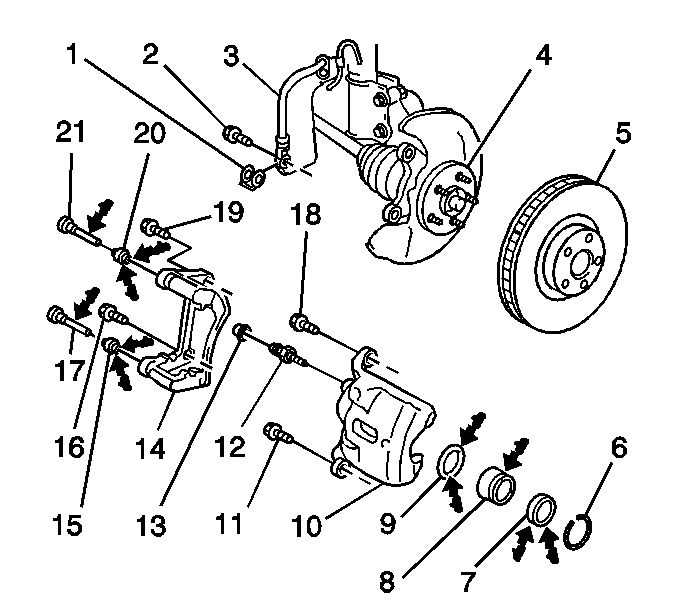
- Install the caliper housing (10)
to the caliper bracket (14).
Notice: Refer to Fastener Notice in the Preface section.
- Install the caliper bolts (11,18).
Tighten
Tighten the bolts to 34.3 N·m (25.30 lb ft).
- Install the tire and wheel assembly to the vehicle. Refer to
Tire and Wheel Removal and Installation
in Tires and
Wheels.
- Lower the vehicle.
- With the engine OFF, gradually apply and release the brake pedal several
times in order to position the caliper pistons and the brake pads.
- Fill the master cylinder fluid reservoir. Refer to
Master Cylinder Reservoir Filling
in Hydraulic Brakes.
- Burnish the pads and the rotors. Refer to
Brake Pad and Rotor Burnishing
.









